Layton 2011 su Marla Singer (PDF)
File information
Title: Microsoft Word - Final Layton.docx
Author: Caro
This PDF 1.3 document has been generated by Microsoft Word / Mac OS X 10.5.8 Quartz PDFContext, and has been sent on pdf-archive.com on 15/06/2017 at 22:30, from IP address 151.28.x.x.
The current document download page has been viewed 478 times.
File size: 447.55 KB (23 pages).
Privacy: public file
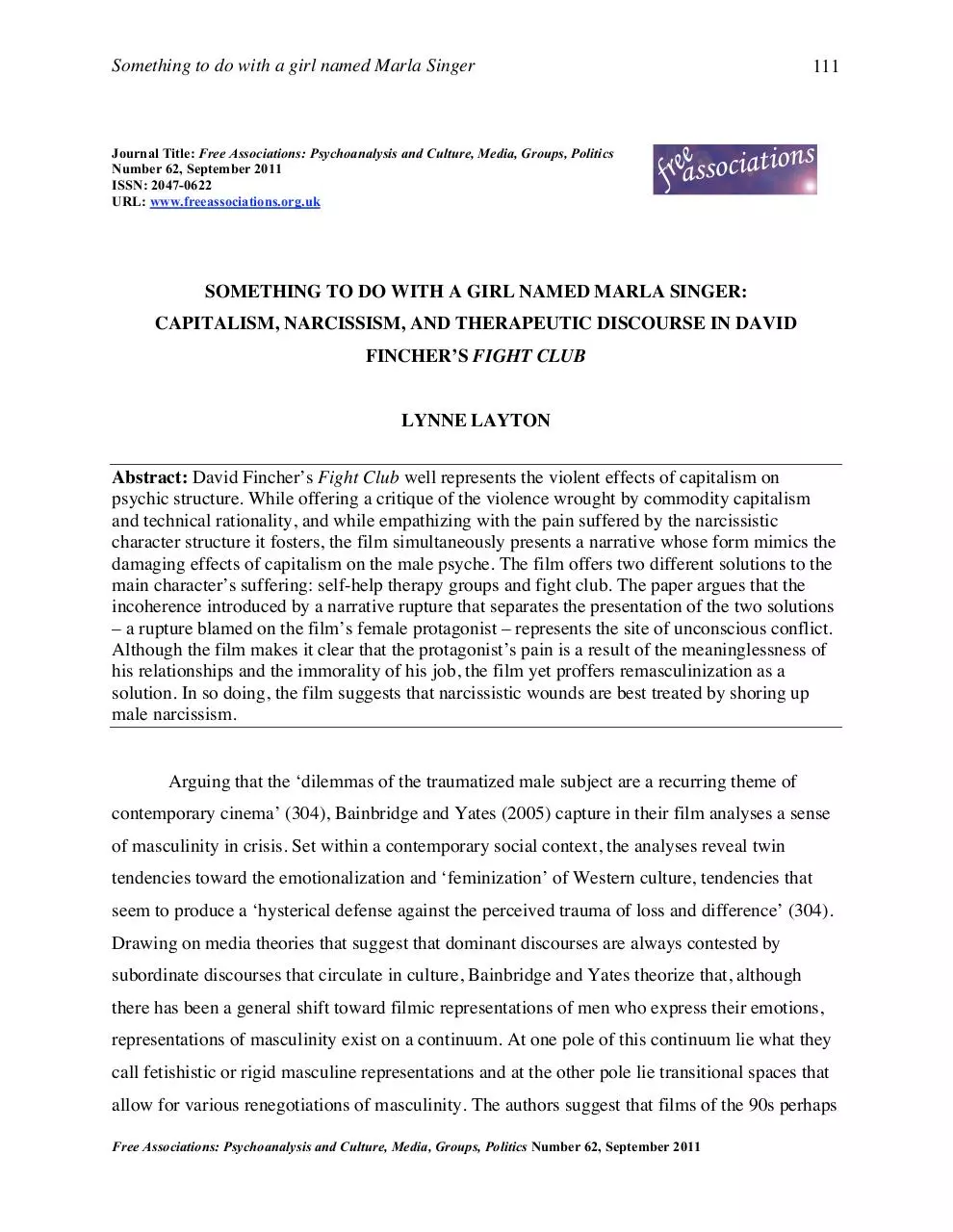
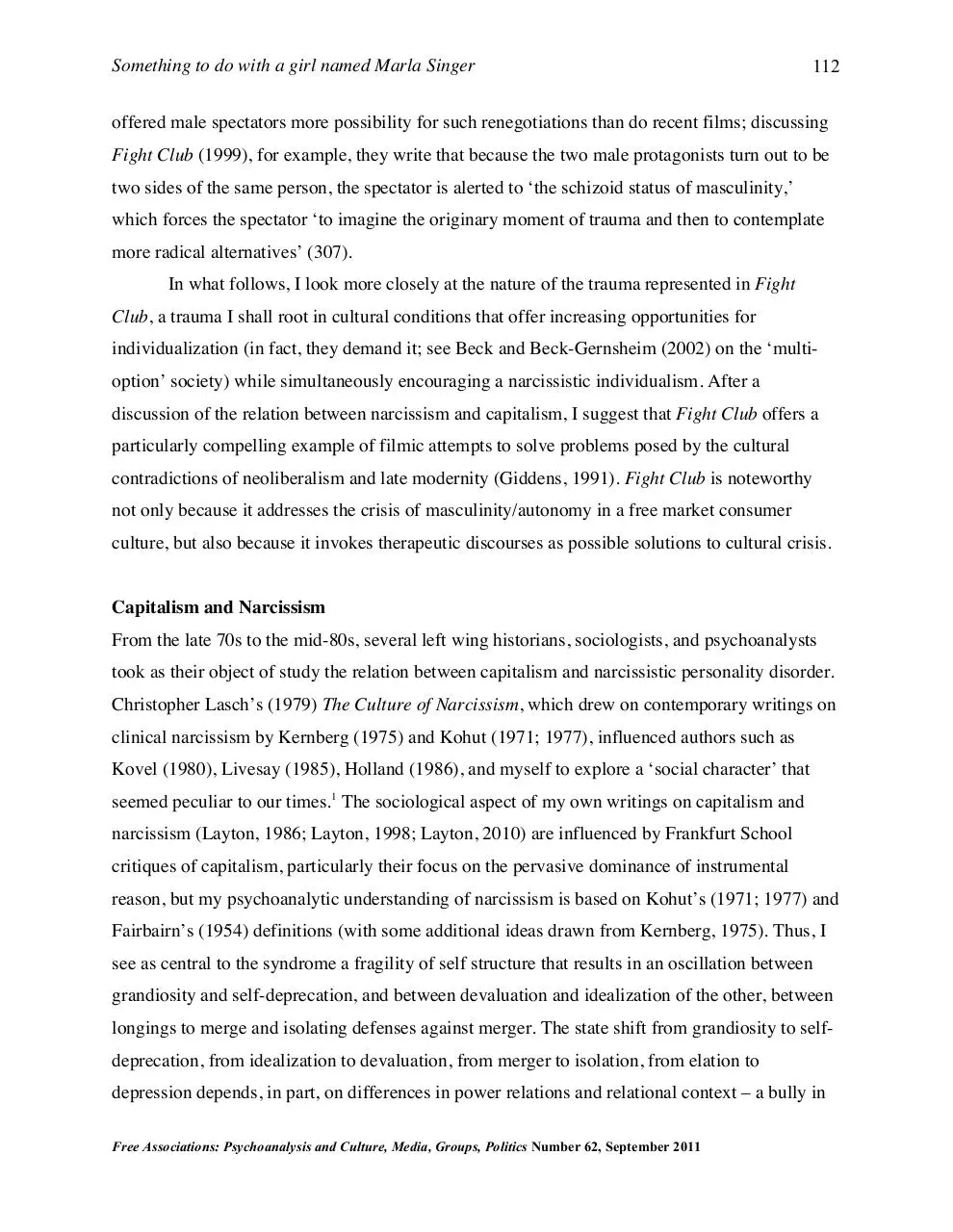
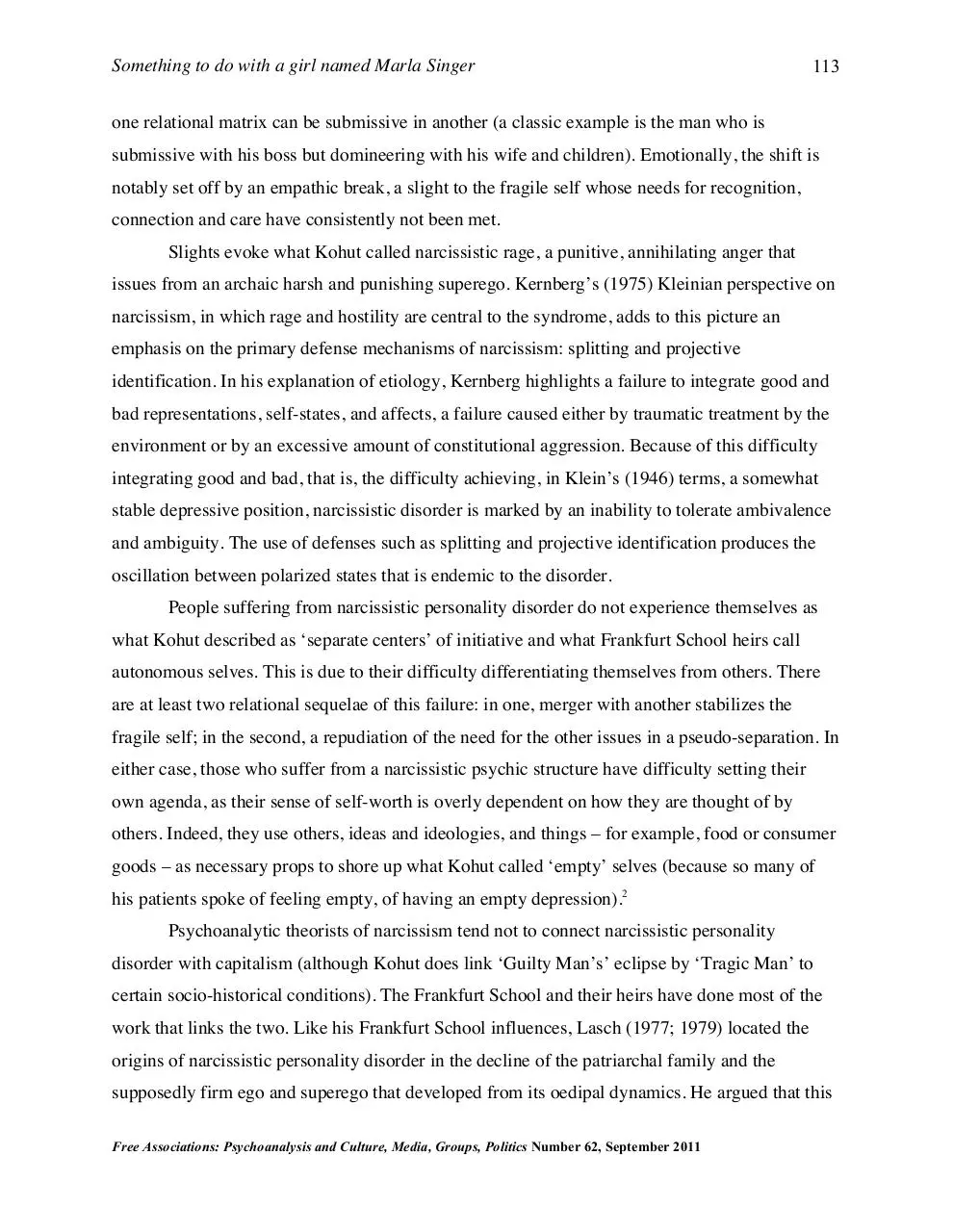
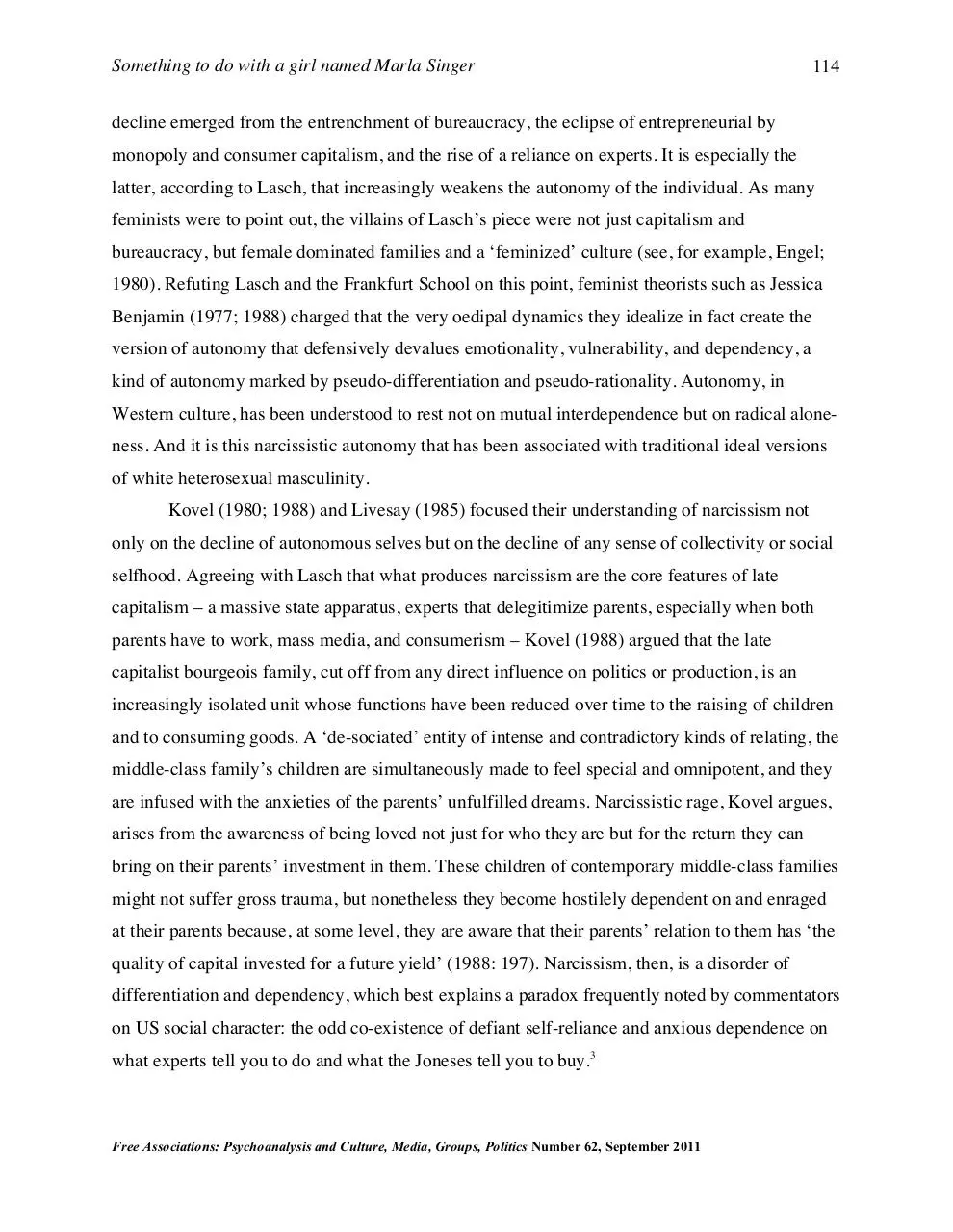
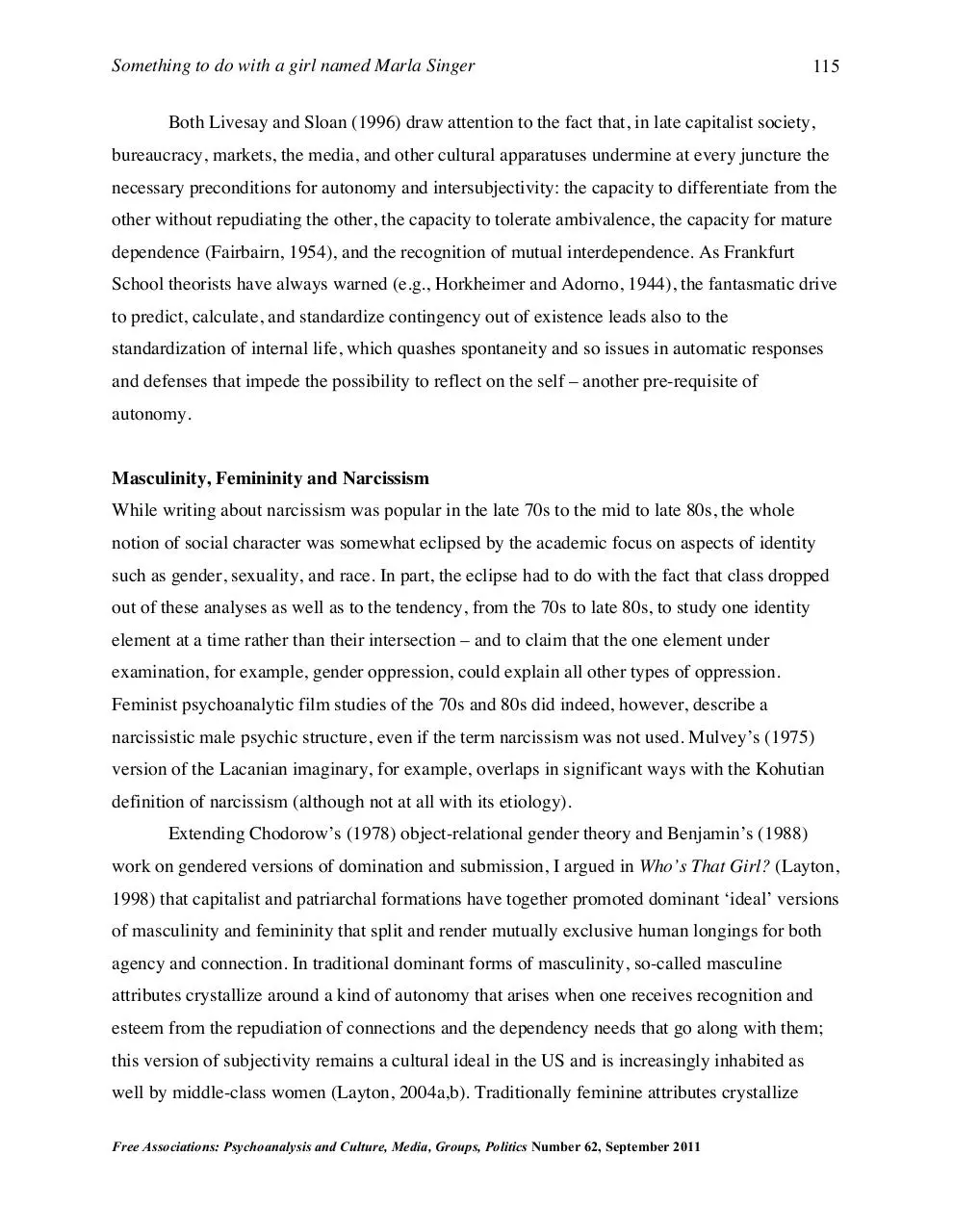
File preview
Something to do with a girl named Marla Singer
111
Journal Title: Free Associations: Psychoanalysis and Culture, Media, Groups, Politics
Number 62, September 2011
ISSN: 2047-0622
URL: www.freeassociations.org.uk
SOMETHING TO DO WITH A GIRL NAMED MARLA SINGER:
CAPITALISM, NARCISSISM, AND THERAPEUTIC DISCOURSE IN DAVID
FINCHER’S FIGHT CLUB
LYNNE LAYTON
Abstract: David Fincher’s Fight Club well represents the violent effects of capitalism on
psychic structure. While offering a critique of the violence wrought by commodity capitalism
and technical rationality, and while empathizing with the pain suffered by the narcissistic
character structure it fosters, the film simultaneously presents a narrative whose form mimics the
damaging effects of capitalism on the male psyche. The film offers two different solutions to the
main character’s suffering: self-help therapy groups and fight club. The paper argues that the
incoherence introduced by a narrative rupture that separates the presentation of the two solutions
– a rupture blamed on the film’s female protagonist – represents the site of unconscious conflict.
Although the film makes it clear that the protagonist’s pain is a result of the meaninglessness of
his relationships and the immorality of his job, the film yet proffers remasculinization as a
solution. In so doing, the film suggests that narcissistic wounds are best treated by shoring up
male narcissism.
Arguing that the ‘dilemmas of the traumatized male subject are a recurring theme of
contemporary cinema’ (304), Bainbridge and Yates (2005) capture in their film analyses a sense
of masculinity in crisis. Set within a contemporary social context, the analyses reveal twin
tendencies toward the emotionalization and ‘feminization’ of Western culture, tendencies that
seem to produce a ‘hysterical defense against the perceived trauma of loss and difference’ (304).
Drawing on media theories that suggest that dominant discourses are always contested by
subordinate discourses that circulate in culture, Bainbridge and Yates theorize that, although
there has been a general shift toward filmic representations of men who express their emotions,
representations of masculinity exist on a continuum. At one pole of this continuum lie what they
call fetishistic or rigid masculine representations and at the other pole lie transitional spaces that
allow for various renegotiations of masculinity. The authors suggest that films of the 90s perhaps
Free Associations: Psychoanalysis and Culture, Media, Groups, Politics Number 62, September 2011
Something to do with a girl named Marla Singer
112
offered male spectators more possibility for such renegotiations than do recent films; discussing
Fight Club (1999), for example, they write that because the two male protagonists turn out to be
two sides of the same person, the spectator is alerted to ‘the schizoid status of masculinity,’
which forces the spectator ‘to imagine the originary moment of trauma and then to contemplate
more radical alternatives’ (307).
In what follows, I look more closely at the nature of the trauma represented in Fight
Club, a trauma I shall root in cultural conditions that offer increasing opportunities for
individualization (in fact, they demand it; see Beck and Beck-Gernsheim (2002) on the ‘multioption’ society) while simultaneously encouraging a narcissistic individualism. After a
discussion of the relation between narcissism and capitalism, I suggest that Fight Club offers a
particularly compelling example of filmic attempts to solve problems posed by the cultural
contradictions of neoliberalism and late modernity (Giddens, 1991). Fight Club is noteworthy
not only because it addresses the crisis of masculinity/autonomy in a free market consumer
culture, but also because it invokes therapeutic discourses as possible solutions to cultural crisis.
Capitalism and Narcissism
From the late 70s to the mid-80s, several left wing historians, sociologists, and psychoanalysts
took as their object of study the relation between capitalism and narcissistic personality disorder.
Christopher Lasch’s (1979) The Culture of Narcissism, which drew on contemporary writings on
clinical narcissism by Kernberg (1975) and Kohut (1971; 1977), influenced authors such as
Kovel (1980), Livesay (1985), Holland (1986), and myself to explore a ‘social character’ that
seemed peculiar to our times.1 The sociological aspect of my own writings on capitalism and
narcissism (Layton, 1986; Layton, 1998; Layton, 2010) are influenced by Frankfurt School
critiques of capitalism, particularly their focus on the pervasive dominance of instrumental
reason, but my psychoanalytic understanding of narcissism is based on Kohut’s (1971; 1977) and
Fairbairn’s (1954) definitions (with some additional ideas drawn from Kernberg, 1975). Thus, I
see as central to the syndrome a fragility of self structure that results in an oscillation between
grandiosity and self-deprecation, and between devaluation and idealization of the other, between
longings to merge and isolating defenses against merger. The state shift from grandiosity to selfdeprecation, from idealization to devaluation, from merger to isolation, from elation to
depression depends, in part, on differences in power relations and relational context – a bully in
Free Associations: Psychoanalysis and Culture, Media, Groups, Politics Number 62, September 2011
Something to do with a girl named Marla Singer
113
one relational matrix can be submissive in another (a classic example is the man who is
submissive with his boss but domineering with his wife and children). Emotionally, the shift is
notably set off by an empathic break, a slight to the fragile self whose needs for recognition,
connection and care have consistently not been met.
Slights evoke what Kohut called narcissistic rage, a punitive, annihilating anger that
issues from an archaic harsh and punishing superego. Kernberg’s (1975) Kleinian perspective on
narcissism, in which rage and hostility are central to the syndrome, adds to this picture an
emphasis on the primary defense mechanisms of narcissism: splitting and projective
identification. In his explanation of etiology, Kernberg highlights a failure to integrate good and
bad representations, self-states, and affects, a failure caused either by traumatic treatment by the
environment or by an excessive amount of constitutional aggression. Because of this difficulty
integrating good and bad, that is, the difficulty achieving, in Klein’s (1946) terms, a somewhat
stable depressive position, narcissistic disorder is marked by an inability to tolerate ambivalence
and ambiguity. The use of defenses such as splitting and projective identification produces the
oscillation between polarized states that is endemic to the disorder.
People suffering from narcissistic personality disorder do not experience themselves as
what Kohut described as ‘separate centers’ of initiative and what Frankfurt School heirs call
autonomous selves. This is due to their difficulty differentiating themselves from others. There
are at least two relational sequelae of this failure: in one, merger with another stabilizes the
fragile self; in the second, a repudiation of the need for the other issues in a pseudo-separation. In
either case, those who suffer from a narcissistic psychic structure have difficulty setting their
own agenda, as their sense of self-worth is overly dependent on how they are thought of by
others. Indeed, they use others, ideas and ideologies, and things – for example, food or consumer
goods – as necessary props to shore up what Kohut called ‘empty’ selves (because so many of
his patients spoke of feeling empty, of having an empty depression).2
Psychoanalytic theorists of narcissism tend not to connect narcissistic personality
disorder with capitalism (although Kohut does link ‘Guilty Man’s’ eclipse by ‘Tragic Man’ to
certain socio-historical conditions). The Frankfurt School and their heirs have done most of the
work that links the two. Like his Frankfurt School influences, Lasch (1977; 1979) located the
origins of narcissistic personality disorder in the decline of the patriarchal family and the
supposedly firm ego and superego that developed from its oedipal dynamics. He argued that this
Free Associations: Psychoanalysis and Culture, Media, Groups, Politics Number 62, September 2011
Something to do with a girl named Marla Singer
114
decline emerged from the entrenchment of bureaucracy, the eclipse of entrepreneurial by
monopoly and consumer capitalism, and the rise of a reliance on experts. It is especially the
latter, according to Lasch, that increasingly weakens the autonomy of the individual. As many
feminists were to point out, the villains of Lasch’s piece were not just capitalism and
bureaucracy, but female dominated families and a ‘feminized’ culture (see, for example, Engel;
1980). Refuting Lasch and the Frankfurt School on this point, feminist theorists such as Jessica
Benjamin (1977; 1988) charged that the very oedipal dynamics they idealize in fact create the
version of autonomy that defensively devalues emotionality, vulnerability, and dependency, a
kind of autonomy marked by pseudo-differentiation and pseudo-rationality. Autonomy, in
Western culture, has been understood to rest not on mutual interdependence but on radical aloneness. And it is this narcissistic autonomy that has been associated with traditional ideal versions
of white heterosexual masculinity.
Kovel (1980; 1988) and Livesay (1985) focused their understanding of narcissism not
only on the decline of autonomous selves but on the decline of any sense of collectivity or social
selfhood. Agreeing with Lasch that what produces narcissism are the core features of late
capitalism – a massive state apparatus, experts that delegitimize parents, especially when both
parents have to work, mass media, and consumerism – Kovel (1988) argued that the late
capitalist bourgeois family, cut off from any direct influence on politics or production, is an
increasingly isolated unit whose functions have been reduced over time to the raising of children
and to consuming goods. A ‘de-sociated’ entity of intense and contradictory kinds of relating, the
middle-class family’s children are simultaneously made to feel special and omnipotent, and they
are infused with the anxieties of the parents’ unfulfilled dreams. Narcissistic rage, Kovel argues,
arises from the awareness of being loved not just for who they are but for the return they can
bring on their parents’ investment in them. These children of contemporary middle-class families
might not suffer gross trauma, but nonetheless they become hostilely dependent on and enraged
at their parents because, at some level, they are aware that their parents’ relation to them has ‘the
quality of capital invested for a future yield’ (1988: 197). Narcissism, then, is a disorder of
differentiation and dependency, which best explains a paradox frequently noted by commentators
on US social character: the odd co-existence of defiant self-reliance and anxious dependence on
what experts tell you to do and what the Joneses tell you to buy.3
Free Associations: Psychoanalysis and Culture, Media, Groups, Politics Number 62, September 2011
Something to do with a girl named Marla Singer
115
Both Livesay and Sloan (1996) draw attention to the fact that, in late capitalist society,
bureaucracy, markets, the media, and other cultural apparatuses undermine at every juncture the
necessary preconditions for autonomy and intersubjectivity: the capacity to differentiate from the
other without repudiating the other, the capacity to tolerate ambivalence, the capacity for mature
dependence (Fairbairn, 1954), and the recognition of mutual interdependence. As Frankfurt
School theorists have always warned (e.g., Horkheimer and Adorno, 1944), the fantasmatic drive
to predict, calculate, and standardize contingency out of existence leads also to the
standardization of internal life, which quashes spontaneity and so issues in automatic responses
and defenses that impede the possibility to reflect on the self – another pre-requisite of
autonomy.
Masculinity, Femininity and Narcissism
While writing about narcissism was popular in the late 70s to the mid to late 80s, the whole
notion of social character was somewhat eclipsed by the academic focus on aspects of identity
such as gender, sexuality, and race. In part, the eclipse had to do with the fact that class dropped
out of these analyses as well as to the tendency, from the 70s to late 80s, to study one identity
element at a time rather than their intersection – and to claim that the one element under
examination, for example, gender oppression, could explain all other types of oppression.
Feminist psychoanalytic film studies of the 70s and 80s did indeed, however, describe a
narcissistic male psychic structure, even if the term narcissism was not used. Mulvey’s (1975)
version of the Lacanian imaginary, for example, overlaps in significant ways with the Kohutian
definition of narcissism (although not at all with its etiology).
Extending Chodorow’s (1978) object-relational gender theory and Benjamin’s (1988)
work on gendered versions of domination and submission, I argued in Who’s That Girl? (Layton,
1998) that capitalist and patriarchal formations have together promoted dominant ‘ideal’ versions
of masculinity and femininity that split and render mutually exclusive human longings for both
agency and connection. In traditional dominant forms of masculinity, so-called masculine
attributes crystallize around a kind of autonomy that arises when one receives recognition and
esteem from the repudiation of connections and the dependency needs that go along with them;
this version of subjectivity remains a cultural ideal in the US and is increasingly inhabited as
well by middle-class women (Layton, 2004a,b). Traditionally feminine attributes crystallize
Free Associations: Psychoanalysis and Culture, Media, Groups, Politics Number 62, September 2011
Something to do with a girl named Marla Singer
116
around a kind of connection or relatedness that arises when one is consistently not recognized
and/or humiliated for asserting one’s own agenda. These split masculine and feminine subject
positions incarnate two different versions of narcissism. Although all who suffer from
narcissistic disorder show both sides of these splits, generally people lead with one set of
defenses and hide the other side. Thus, one dominant masculine version of narcissism articulates
grandiosity with devaluation of the other and with isolating defenses against merger, while a
traditionally dominant female version articulates self-deprecation, idealization of the other, and a
defensive longing to merge and lose oneself in the other (Layton, 1988). Because it is a
dialectical disorder, the two types tend to seek out one another to couple, generally causing
lifelong misery as each tries to heal the split in ways that simply fortify it. To fully understand
the narcissistic injury brought about by the demand to split off longings such as dependency or
agency is to recognize that such longings do not disappear from the psyche. Indeed, those who
repudiate dependency keep their distance from connection precisely because they are extremely
vulnerable to any kind of rejection. Ashamed of and full of self loathing for continuing to have
dependency longings, any stirring of them produces defensive enactments and narcissistic rage.
What definitively got lost in filmic gender studies of the 70s and 80s was the connection
between gender theory and capitalism or class (an exception is Walkerdine, 1986). Now that
social class is back on the academic radar screen and there is agreement on the necessity of
analyzing the way identity elements intersect, it seems a good time to return to the relation
between gender, race, class, narcissism and capitalism, this time with the advantage of the more
sophisticated analyses of the way ideology works that we find in the theories of Hall (1982),
Laclau and Mouffe (1985), Stavrakakis (2007), Glynos (2008), and Žižek (1989). What those
who write about capitalism and narcissism tell us is that key to the production of narcissism is
the radical separation of the individual from the social that marks US culture, and the fact that
capitalism’s instrumental forms of domination find their way into the very heart of the family.
And what feminist theory suggests is that the repudiation of dependency, demanded by both that
radical separation and by disavowal, finds its way also into split, narcissistic
gender/race/class/sexual identities. Those theorists, like myself, who feel that psychoanalysis can
most fruitfully be used to understand social character, generally believe that a given era
engenders particular collective psychological responses to its social contradictions, particular
kinds of transferences and particular repetition compulsions.
Free Associations: Psychoanalysis and Culture, Media, Groups, Politics Number 62, September 2011
Something to do with a girl named Marla Singer
117
Popular Culture and Therapeutic Culture
Fantasy productions symbolize and seek solutions to the psychic problems that a culture of
narcissism creates. So-called ‘chick flicks,’ for example, wrestle with the seeming impossibility
to integrate relatedness and agency. And the ‘crisis of masculinity’ films analyzed by Bainbridge
and Yates reflect, among other things, the longing to find a way out of the paradoxical command
to be both self-reliant and emotionally sensitive and connected. But what we often find in ‘crisis
of masculinity’ texts is that the threats to male autonomy are located not in the contradictions of
capitalism and class domination from which they originate, but rather in women, blacks, the
poor, and other subjects onto whom the despised dependency and need have been ragefully
projected. Narrative incoherencies that signal the unconscious of these works often
simultaneously reveal and conceal the dread of dependency and vulnerability that ever more
starkly marks the US culture in which they were produced (especially after 9/11 and the
economic crisis of 2008).
In following the Frankfurt School and its heirs, my cultural analysis thus far has not been
as dialectical as it needs to be to understand the complexity of contemporary subjectivity. Like
Beck and Beck-Gernsheim (2002) as well as Giddens (1991), I do believe that the disembedding
from all traditional anchors of selfhood that has rapidly increased since the end of World War II
has both progressive and anti-progressive moments. Individualization, the opportunity and the
demand to create a life of one’s own exists in tension with narcissistic individualism (or what I
and others have called neoliberal versions of subjectivity, see Layton, 2010). As Giddens (1991)
writes, the do-it-yourself biography teeters on the edge of an ever-present possibility that it will
become a breakdown biography. There is no question that, as Bainbridge and Yates (2005)
suggest, contemporary popular representations of masculinity ‘open up spaces in which
alternative modes of masculinity can be imagined through the affectively-nuanced process of
spectatorship that they demand’ (306-7). And their notion of a continuum well captures the
reality that a ‘masculinity in crisis’ narrative sometimes resolves in a rigid narcissism and
sometimes in the opening of transitional space.
Affects such as anger can, in fact, put one more deeply in touch with the self and others –
or they can defensively function to tear down self and others. To account for what they
understand to be a fairly recent shift in Western culture toward valuing emotional expression,
Free Associations: Psychoanalysis and Culture, Media, Groups, Politics Number 62, September 2011
Something to do with a girl named Marla Singer
118
Richards and Brown (2002) have argued that we live in a ‘therapeutic culture’, the key features
of which are expressivity (id), knowledge (ego), and compassion (superego). To be authentically
therapeutic, however, they argue that such a cultural constellation must also include a reparative
impulse (101). Without such an impulse an ‘id-type emotionality’ substitutes for what they call
‘thoughtful feeling.’ Like Bainbridge and Yates, Richards and Brown are mindful of the tension
between the progressive possibilities of therapeutic culture, in which emotionality is linked with
thought, and its regressive possibilities, in which emotionality is linked with sentimentality, false
selves, and artifice.
Popular media can, as the authors suggest, clearly promote thoughtful feeling-type
expressions of therapeutic culture. In clinical work, I have often found that patients use popular
media representations as one means of forging identifications that counter the restrictive and
damaging identifications on offer in their families: for example, one patient used Patrick
Stewart’s version of masculinity in Star Trek to contest his conviction that only macho versions
of masculinity counted as masculine (see Layton, 1998: Ch. 7). Another used the same figure to
enable her to reflect on alternative modes of leadership besides the sado-masochistic ones to
which she continued to find herself prey.
Media texts, however, are complex phenomena. As Jameson (1979) pointed out many
years ago, popular texts’ popularity is in no small measure due to their tendency to combine both
progressive and anti-progressive elements, and they do so in various ways, for example, by
creating contradictory identificatory and transferential possibilities, or by throwing up
contradictions between form and content (where, for example, anti-progressive form might
undercut progressive content). Promoting both id-type and thoughtful feeling versions of
emotional expression, popular texts provide audiences with both non-normative and normative
transferential possibilities. They may provoke in the spectator what I have referred to as
normative unconscious processes or enactments (Layton, 2006), inviting unconscious collusions
with such oppressive norms as sexism or racism. At the same time, since meaning can never be
fixed and identities are fluid, the very same popular texts may well invite unpredictable
decodings that challenge oppressive norms and normative transferences (Hall, 1980). And media
texts contain unconscious subtexts that defy the intentionality of their authors and that disrupt
any possibility of narrative coherence.
Free Associations: Psychoanalysis and Culture, Media, Groups, Politics Number 62, September 2011
Something to do with a girl named Marla Singer
119
David Fincher’s 1999 film, Fight Club provides a compelling example of these popular
culture theses as it wrangles with the fine lines existing between a culture of individualization
and a culture of narcissistic individualism. After numerous viewings and numerous teaching
experiences (in which I have found that students see the film very differently from how I see it –
an argument for the necessity of audience studies), I continue to find the film puzzling in its
strange mixture of anti-capitalist critique and simultaneous proffering of id-type and thoughtful
feeling-type solutions. Indeed, in the film, therapeutic discourse is evoked as a solution to the
protagonist’s cultural malaise, only to be abruptly discarded and replaced by a sadistic and
violent discourse (that itself, at times, draws on psychological narratives). Narrative
discontinuities seem to signal the film’s confusion in this regard. In what follows, I offer my own
reading of the film and end with some alternative readings. I hope along the way to elucidate
some of the normative and non-normative transference possibilities that arise from the film’s
particular way of linking masculinity, narcissism and capitalism.
Fight Club
Fight Club came out in 1999, at the end of two decades of filmic testaments to white male anger.
So many of these films – an uncommonly large number of which starred Michael Douglas –
pinned blame for threats to male autonomy squarely on women. A prime example is Barry
Levinson’s (1994) Disclosure, in which Michael Douglas is passed over for an expected
promotion that goes instead to Demi Moore, an ex-girlfriend. Moore engineers a scene that
makes it look as though Douglas sexually harassed her, and most of the film focuses on
Douglas’s attempts to clear his name, which he does at the end. At one or two moments, the
film’s class unconscious erupts and it becomes clear that the real causes of Douglas’s and other
unemployed men’s problems are the machinations of upper class male bosses focused solely on
the bottom line. But this truth is very much background to the foreground fear of female
emasculators.
Fight Club is far more explicitly critical of capitalism than most films in the white male
anger genre. Its protagonists are also younger than those the genre usually depicts. And yet, rage
about the way capitalism and hegemonic masculinity thwart longings both for agency and
connection are deflected onto women in this film as well. Like Lasch’s analysis of narcissism,
the film simply cannot seem to decide whether or not its male protagonists’ problems are caused
Free Associations: Psychoanalysis and Culture, Media, Groups, Politics Number 62, September 2011
Download Layton 2011 su Marla Singer
Layton 2011 su Marla Singer.pdf (PDF, 447.55 KB)
Download PDF
Share this file on social networks
Link to this page
Permanent link
Use the permanent link to the download page to share your document on Facebook, Twitter, LinkedIn, or directly with a contact by e-Mail, Messenger, Whatsapp, Line..
Short link
Use the short link to share your document on Twitter or by text message (SMS)
HTML Code
Copy the following HTML code to share your document on a Website or Blog
QR Code to this page

This file has been shared publicly by a user of PDF Archive.
Document ID: 0000612829.